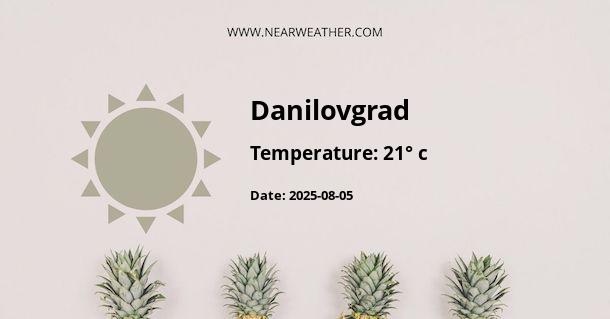Understanding Danilovgrad, Montenegro: A Detailed Climatic Overview
Danilovgrad, located in the central part of Montenegro, experiences a climate that is both Mediterranean and continental, offering distinct seasons throughout the year. This in-depth examination will delve into the various climatic nuances, from temperature fluctuations to precipitation patterns, providing a comprehensive guide for anyone interested in the weather dynamics of Danilovgrad.
Seasonal Climate Variations in Danilovgrad
The weather in Danilovgrad is characterized by warm summers and relatively cold winters, with transitional spring and autumn seasons that bridge the temperature extremes.
Winter Climate
Winter in Danilovgrad typically extends from December to February. Despite being in the Mediterranean region, the inland position and elevation of Danilovgrad contribute to colder winter temperatures compared to coastal areas. During this season, average temperatures can drop below freezing, especially at night.
Spring Climate
From March to May, Danilovgrad undergoes a period of spring, marked by a gradual increase in temperatures and a renewal of flora. Though spring brings a rise in average temperatures, late frost events are not uncommon in the earlier months.
Summer Climate
The summer season, lasting from June to August, exhibits high temperatures that can frequently reach 30°C (86°F) or above. The influence of the Mediterranean climate is more pronounced during this period, with high temperatures and reduced precipitation.
Autumn Climate
As the hot summer gives way to cooler weather, autumn, from September to November, experiences a gradual decrease in daily temperatures. Although precipitation begins to rise, this season often enjoys some of the most pleasant weather, with moderate temperatures and lower humidity.
Temperature Patterns Throughout The Year
| Month | Min Temperature (°C) | Max Temperature (°C) | Average Temperature (°C) |
|---|---|---|---|
| January | -2 | 6 | 2 |
| February | 0 | 8 | 4 |
| March | 2 | 12 | 7 |
| April | 6 | 17 | 11.5 |
| May | 10 | 23 | 16.5 |
| June | 13 | 26 | 19.5 |
| July | 15 | 30 | 22.5 |
| August | 15 | 30 | 22.5 |
| September | 12 | 25 | 18.5 |
| October | 8 | 19 | 13.5 |
| November | 4 | 12 | 8 |
| December | 0 | 7 | 3.5 |
Note: The provided temperature values are approximate averages based on historical climatic data and can vary from year to year.
Precipitation Trends in Danilovgrad
- The annual precipitation in Danilovgrad averages around 1500 mm, with the distribution being uneven over the year.
- Autumn and winter months tend to be the wettest, with November often being the peak of precipitation.
- The summer season sees significantly less rainfall, aligning with the typical Mediterranean climate features.
Precipitation Chart
| Month | Rainfall (mm) | Rainy Days |
|---|---|---|
| January | 200 | 12 |
| February | 180 | 11 |
| March | 165 | 12 |
| April | 155 | 13 |
| May | 86 | 11 |
| June | 60 | 9 |
| July | 50 | 7 |
| August | 58 | 8 |
| September | 100 | 9 |
| October | 180 | 11 |
| November | 210 | 13 |
| December | 220 | 14 |
The figures above reflect general trends, but actual conditions can be influenced by diverse factors, including global climate patterns and year-to-year variability.
Snowfall and Extreme Weather Events
- Snowfall in Danilovgrad is a seasonal occurrence, primarily happening from December through February, with snow cover typically lasting for several days to weeks.
- The area can experience frosts, particularly during the winter months, which can impact local agriculture and day-to-day life.
- Extreme weather events, while not common, can include occurrences of heavy rainfall leading to localized flooding, particularly during the autumn months when the precipitation is heaviest.
Wind Patterns
- Bora Winds: The Bora is a dry, cold down-slope wind that can affect Danilovgrad, particularly in winter. Known for its gusty nature, the Bora can cause sudden drops in temperature and challenging conditions for outdoor activities.
- Sirocco Winds: Alternatively, the Sirocco is a warm, humid wind from the south, which is most common in the spring and autumn. It can bring unseasonably warm temperatures and, occasionally, dust or sand from Africa's deserts.
Practical Considerations for Visiting or Living in Danilovgrad
Considering the climate of Danilovgrad is essential for planning any activities, whether for travel or day-to-day life:
- Wardrobe choices should be seasonally appropriate, with layers recommended for the colder months and breathable, light clothing for the hot summers.
- When engaging in agricultural or gardening activities, be mindful of the risk of late or early frosts that could affect plant growth.
- Staying updated with local weather forecasts can be crucial, as sudden changes can occur, particularly with respect to precipitation and wind events.
Conclusion
In conclusion, Danilovgrad presents a climate influenced by both Mediterranean and continental characteristics, with warm, dry summers and colder, wetter winters. The area's weather can vary, so being prepared for the region's diverse conditions is key. With proper planning and awareness of seasonal trends, one can enjoy the natural beauty and outdoor opportunities that Danilovgrad has to offer throughout the year.
Whether you're writing content for weather enthusiasts, travelers planning their next trip, or locals seeking a more detailed understanding of their environment, being thorough, using industry-specific language, and incorporating up-to-date and scientific-backed data is essential for creating highly informative and engaging content.
A - Danilovgrad's Latitude is 42.553841 & Longitude is 19.146080.
A - Weather in Danilovgrad is 5° today.
A - Climate Conditions in Danilovgrad shows overcast clouds today.
A - Humidity in Danilovgrad is 88% today.
A - Wind speed in Danilovgrad is 6.91 km/h, flowing at 109° wind direction. today.
